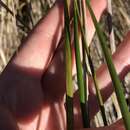Comprehensive Description
(
anglais
)
fourni par North American Flora
Spartina bakeri Merrill, Bull. U. S. Dep. Agr. PI. Ind 9: 14. 1902.
spartina juncea var. Bakeri St. Yves, Candollea S: 27, 91. 1932. (Based on S. Bakeri Merrill.)
Culms 1-2 meters tall, in large dense very tough clumps, erect from very short knotty rhizomes, sometimes with fascicles of branches at the nodes; sheaths usually much longer than the internodes, rounded on the back; ligule ciliate, 0.5-2 mm. long; blades elongate, 4-8 mm. wide at the base, firm, involute or rarely flat, glabrous on the lower surface, very scabrous on the upper surface and on the margins; panicle 10-20 cm. long; spikes 5-12, 3-6 cm. long, approximate but not crowded, appressed or narrowly ascending, sessile, or the lower with a peduncle as much as 1 cm. long, the rachis glabrous or very sparsely scabrous on the margins; spikelets closely appressed, 6-8 mm. long; glumes acute or acuminate, scabrous, especially on the keels, the first about half as long as the lemma, the second exceeding it; lemma 5-6 mm. long, subacute or obtuse, shallowly lobed, more or less scabrous on the keel and on the margins; palea slightly exceeding the lemma.
Type locality: Lake Ola, Florida (C. H. Baker 14).
Distribution: Sandy or marshy ground, usually near the coast. South Carolina, Georgia, and Florida.
- citation bibliographique
- Albert Spear Hitchcock, Jason Richard Swallen, Agnes Chase. 1939. (POALES); POACEAE (pars). North American flora. vol 17(8). New York Botanical Garden, New York, NY
Physical Description
(
anglais
)
fourni par USDA PLANTS text
Perennials, Aquatic, leaves emergent, Terrestrial, not aquatic, Stems nodes swollen or brittle, Stems erect or ascending, Stems caespitose, tufted, or clustered, Stems terete, round in cross section, or polygonal, Stem internodes solid or spongy, Stem internodes hollow, Stems with infloresc ence less than 1 m tall, Stems with inflorescence 1-2 m tall, Stems, culms, or scapes exceeding basal leaves, Leaves mostly cauline, Leaves conspicuously 2-ranked, distichous, Leaves sheathing at base, Leaf sheath mostly open, or loose, Leaf sheath smooth, glabrous, Leaf sheath and blade differentiated, Leaf blades linear, Leaf blades very narrow or filiform, less than 2 mm wide, Leaf blades 2-10 mm wide, Leaf blade margins folded, involute, or conduplicate, Leaf blades mostly glabrous, Leaf blades scabrous, roughened, or wrinkled, Ligule present, Ligule a fringe of hairs, Inflorescence terminal, Inflorescence solitary, with 1 spike, fascicle, glomerule, head, or cluster per stem or culm, Inflorescence a panicle with narrowly racemose or spicate branches, Inflorescence with 2-10 branches, Inflorescence branches 1-sided, Rachis angular, Flowers bisexual, Spikelets pedicellate, Spikelets sessile or subsessile, Spikelets laterally compressed, Spikelet less than 3 mm wide, Spik elets with 1 fertile floret, Spikelets solitary at rachis nodes, Spikelets all alike and fertille, Spikelets bisexual, Spikelets disarticulating below the glumes, Spikelets secund, in rows on one side of rachis, Rachilla or pedicel glabrous, Glumes present, empty bracts, Glumes 2 clearly present, Glumes distinctly unequal, Glumes equal to or longer than adjacent lemma, Glume equal to or longer than spikelet, Glumes keeled or winged, Glume surface hairy, villous or pilose, Glumes 1 nerved, Glumes 3 nerved, Lemmas thin, chartaceous, hyaline, cartilaginous, or membranous, Lemma 3 nerved, Lemma glabrous, Lemma body or surface hairy, Lemma apex truncate, rounded, or obtuse, Lemma apex acute or acuminate, Lemma awnless, Lemma margins thin, lying flat, Lemma straight, Palea present, well developed, Palea membranous, hyaline, Palea longer than lemma, Palea 2 nerved or 2 keeled, Stamens 3, Styles 2-fid, deeply 2-branched, Stigmas 2, Fruit - caryopsis.
Sporobolus bakeri: Brief Summary
(
anglais
)
fourni par wikipedia EN
Sporobolus bakeri is a species of grass known by the common names sand cordgrass and bunch cordgrass. It is native to the south-eastern United States, where it grows along the coast and in inland freshwater habitat in Florida.
This species forms dense bunches up to 20 feet wide with stems up to 4 feet tall. The wiry leaves are light green on the undersides and darker on top. During winter the plant is more brown than during summer, when it is brownish-green.
This grass grows in aquatic and semiaquatic habitat, including beaches, ponds, and more upland sites. It may be used to control erosion and can tolerate flooding. It can be grown as an ornamental.
- licence
- cc-by-sa-3.0
- droit d’auteur
- Wikipedia authors and editors

